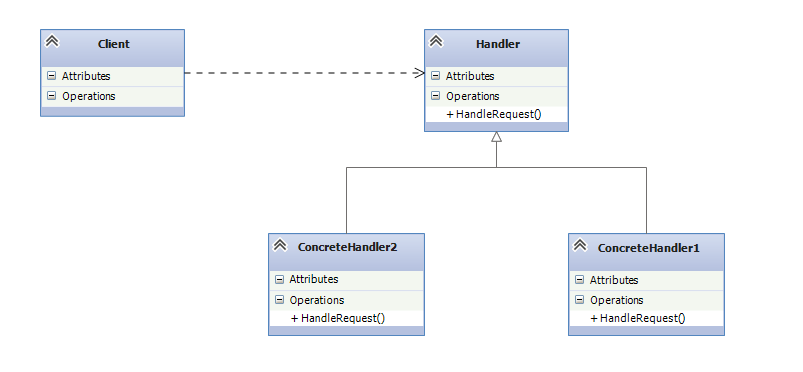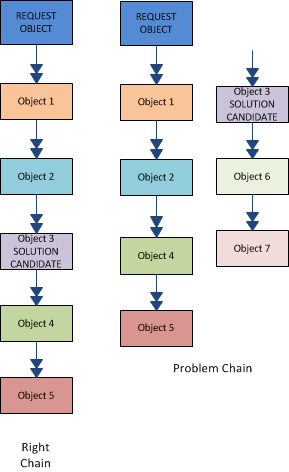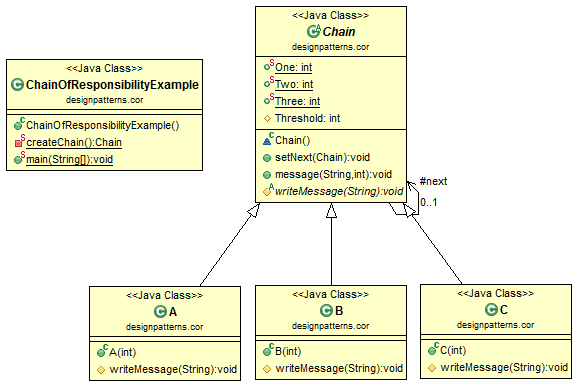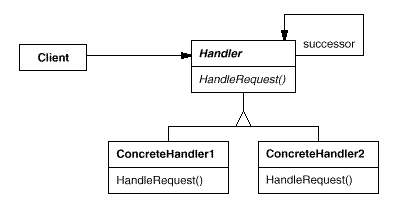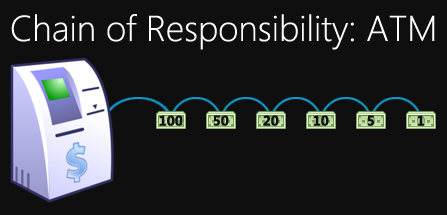The Chain of Responsibility is a behavioral design pattern that processes a request through a series of processor (handlersreceivers) objects. The request is sent from one handler object to. The Chain of Responsibility pattern allows a number of classes to attempt to handle a request, without any of them knowing about the capabilities of the other classes. It provides a loose coupling between these classes; the only common link is the request that is passed between them. This structural code demonstrates the Chain of Responsibility pattern in which several linked objects (the Chain) are offered the opportunity to respond to a request or hand it off to the object next in line. As simple as its name says, this design pattern helps to handle a particular request from a client which needs to be goes through a list of actions or processors. It will navigate through each process by passing the responsibility to the next process. The chain of responsibility pattern is definitely an interesting one. It literally allows us to chain any number of objects, where each has the option of either handling a particular request, or deferring to the next object in the cycle. Pleas subscribe for more videos! In objectoriented design, the pattern is a design pattern consisting of a source of command objects and a series of processing objects. Chain of Responsibility Pattern There are many scenarios under which we might want to apply certain actions that can fall back from a detailed scope to a more general one. A nice example would be the help information of a GUI application: when a user requests help information for a certain part of the user interface, it is expected to show. The Chain of Responsiblity patterns is related to the Chaining Pattern which is frequently used in JavaScript (jQuery makes extensive use of this pattern). To learn more about the Chaining patterns and its benefits see our JavaScript jQuery Design Pattern Framework. The chain of responsibility design pattern falls under the behavioral category and can be used to reduce coupling between the sender of a request and the receiver object that handles the request. (Chain of Responsibility Pattern). In objectoriented design, the pattern is a design pattern consisting of a source of command objects and a series of processing objects. Each processing object contains logic that defines the types of command objects that it can handle; the rest. This Design Patterns refcard provides a quick reference to the original 23 Gang of Four design patterns, as listed in the book Design Patterns: Elements of Reusable ObjectOriented Software. The Chain of Responsibility design pattern allows an object to send a command without knowing what object will receive and handle it. The request is sent from one object to another making them parts of a chain and each object in this chain can handle the command, pass it on or do both. The Chain of Responsibility Pattern is a design pattern whose intent is to avoid coupling the sender of a request to its receivers by giving more than one object a chance to handle a request. The Chain of Responsibility works like this: The receiver objects are added to a chain. The sender object has a reference to the first receiver object in the chain. Filter pattern or Criteria pattern is a design pattern that enables developers to filter a set of objects using different criteria and chaining them in a decoupled way through logical operations. This type of design pattern comes under structural pattern as this pattern combines multiple criteria to. Today, we will be discussing the Chain of Responsibility Pattern. This example decouples the sender and beneficiary of solicitations. This is finished with a chain of articles that can each deal with the demand itself or pass it on to the following item. 3 sections make up the Chain of Responsibility design: sender, recipient, and demand. Creational Abstract Factory Builder Factory Method Object Pool Prototype Singleton Structural Adapter Bridge Composite Decorator Facade Flyweight Private Class Data Proxy Behavioral Chain of Responsibility Command Interpreter Iterator Mediator Memento Null Object Observer State Strategy Template Method Visitor Monad Pattern Promises I've been trying to think up a new chain A simple usage of chain of responsibility design pattern using abstract logger class. This pattern is very widely used and is very easy to understand. Category Implementing Chain of Responsibility Design Pattern in C# using Managed Extensibility Framework (MEF) November 13, 2011 This post is about implementing Chain Of Responsibility design pattern, and few possible extensions to the same. Chain of responsibility implies that there is an order in which the validations must take place. I would probably use something similar to the Strategy pattern where you have a Set of validation strategies that are applied to a specific type of record. Chain of responsibility (COR) decouples the sender of the request and its receiver. Now you must be wondering same one can achieve using Command Pattern also. But with COR, the request is transferred to another object making them part of the chain. Chain of Responsibility Design Pattern in Java: Before and after Back to Chain of Responsibility description Before. The client is responsible for stepping through the list of Handler objects, and determining when the request has been handled. Chain of responsibility forwards the request to a chain of objects but the Command pattern forwards the request only to a specific object. Java chain of responsibility design pattern comes under behavioural design patterns. As the name suggest chain of responsibility design pattern a request will be send to the chain of objects. A JavaScript pattern and antipattern collection that covers function patterns, jQuery patterns, jQuery plugin patterns, design patterns, general patterns, literals and constructor patterns, object creation patterns, code reuse patterns, DOM and browser patterns (upcoming). Using Chain of Responsibility pattern we are avoiding the assumption that One request will processed by only one receiver (responsible object). This is not practically true and is a very important aspect of this pattern and its very advantageous to make a chance to handle a request by more than one object. Today, we'll be talking about the Chain of Responsibility Pattern. This pattern decouples the sender and receiver of requests. This is done with a chain of objects that can each handle the request itself or pass it on to the next object. Read The Chain of Responsibility design pattern is intended to decouple the sender (the DOM element) of an event from the receiver (your code) so that more than one object has a chance to claim responsibility for handling the event (your views and models). The Chain design pattern enables us to connect objects to each other as if they were chains. Before we can implement this design pattern, we will need to update the logic of our core circle to enable it to store the next link in a chain. Today, we'll be talking about the Chain of Responsibility Pattern. This pattern decouples the sender and receiver of requests. This is done with a chain of objects that can each handle the request itself or pass it on to the next object. Chain of Responsibility Structure 3. The Chain of Responsibility pattern avoids coupling the sender of a request to the receiver by giving more than one object a chance to handle the request. ATM use the Chain of Responsibility in money giving mechanism. Chain of Responsibility design pattern in Javascript Clone via HTTPS Clone with Git or checkout with SVN using the repositorys web address. A powerful design pattern geared towards handling an event is the Chain of Responsbility design pattern. This pattern helps decouple related algorithms in C# ASP. NET and can help your software become more scalable and easier to control. In general, the Chain of Responsbility design pattern allows. The chain of responsibility design pattern is a behavioral pattern. As all GOF design patterns, its name suits it perfectly since the pattern defines for a request to handle, a chain of objets which, turntoturn have the ability to stop the chain processing and to response to the request. The chain of responsibility pattern is applied in. The chain of responsibility pattern is a way of communication between objects. As its name indicate a chain of handlers is built and every handler This articles was originally at wiki. net but has now been given a new home on CodeProject. Editing rights for this article has been set at. JavaScript Chain of responsibility design pattern What exactly is the chain of responsibility design pattern? This pattern has a group of objects that are expected to between them be able to solve a problem and if the first object can't solve it, it just simply passes the data to the next object in the chain. Design Patterns design patterns In Chain of Responsibility pattern, we create a chain of objects which handles a particular request. Each object contains a reference to his next object, if the object does not want to handle the request, it's simply forward the request to next object handler. The Chain of Responsibility design pattern seeks to avoid coupling a request to a particular receiver by giving more than one object a chance to handle a particular request. In essence, we pass an object along a chain of potential handlers for that object until one of the handlers deals with the request. Sponsor Open Source development activities and free contents for everyone. The Chain of Responsibility Pattern is a common ObjectOriented Programming (OOP) design pattern that decouples the sender of a request from the receiver by allowing one or many handler objects to handle the request. First up in the Behavioral pattern list is the Chain of Responsibility design pattern, which makes it easy to chain objects together in an ordered set. A specific, logical requirement is passed into the chain and is checked against each object in the set, in order, until a suitable match is found that meets the needs of the particular requirement. The Chain of Responsibility is a very important pattern to learn in software. The intent of this design pattern is to avoid coupling the sender to the receiver by giving more than one object the chance to handle the request. As per GOF guys, Chain of Responsibility pattern is defined as following. Avoid coupling the sender of a request to its receiver by giving more than one object a chance to handle the request. Chain the receiving objects and pass the request along the chain until an object handles it. Welcome to my Chain of Responsibility Design Pattern Tutorial! This pattern has a group of objects that are expected to between them be able to solve a problem. chain of responsibility pattern is used in express middleware, where a request passes through all middleware until one of them responds and send a result command pattern is. Chain of responsibility pattern is used to achieve loose coupling in software design where a request from client is passed to a chain of objects to process them. Later, the object in the chain will decide themselves who will be processing the request and whether the request is required to be sent to. Chain of Responsibility pattern falls under Behavioral Design Patterns of Gang of Four (GOF) Design Patterns in. The chain of responsibility pattern is used to process a list or chain of various types of request and each of them may be handle by a different handler. JavaScript Design Patterns: Chain of Responsibility The rest of the JavaScript Design Patterns series: Singleton Pattern; Bridge Pattern; Composite Pattern; Chain of Responsibility Structure. There are three parts to the Chain of Responsibility pattern: sender, receiver, and request. Learning JavaScript Design Patterns A book by Addy Osmani Volume. Chain of Responsibility: In JavaScript, the Module pattern is used to further emulate the concept of classes in such a way that we're able to include both publicprivate methods and variables inside a single object, thus shielding particular parts from the global. Pattern how to handle complex validation in C# . Data validation is a key aspect of almost any system, incorrect or hacked data can cause a lot of.
